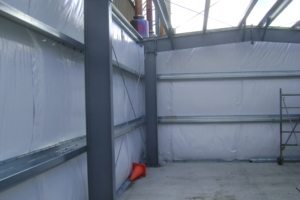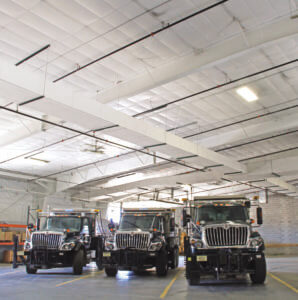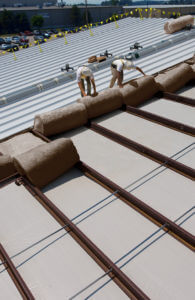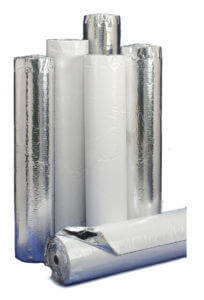High R-value steel building insulation is essential when you need to efficiently control the temperature inside your metal building. If your building is used for cold storage, then it must be insulated with steel building insulation to maintain a consistent temperature, which is often cooler than the exterior. In cold climates, you will also need to use high R-value insulation when you want to maintain a warmer temperature inside than it is outside. Different buildings have different uses and requirements, so not every metal building will require insulation, but most will see extensive benefits from the use of high-quality steel building insulation.
Insulating your steel building is an investment, but it pays off in the long run. If you want to save money on heating and cooling or live in a region with significant temperature changes (like many regions in Canada), the right type of steel building insulation for your Canadian metal building is an idea worth considering. Steel building insulation with the right high R-value is crucial if you want your building to be long-lasting, safe to work in and serve its purpose for many decades.
Metal building insulation not only helps maintain normal working interior temperatures, but it also helps prevent condensation by creating a moisture barrier throughout the walls and roof of your metal building. Condensation can create a lot of problems for your prefabricated metal building, such as mould and mildew, so you need to make sure you make every effort to prevent moisture buildup from happeningThe best insulation for metal buildings can serve this purpose for you, protecting the structure, its contents, and the people who work in the building.
In this article, we will review the science behind metal building insulation design, discuss the important condensation-prevention function of insulating a steel building, introduce our steel building insulation vendor partner, and explain some of the insulation options available to you for your steel building.
How Does Steel Building Insulation Work?
Traditional construction generally requires that insulation is installed between the studs. But when insulating a steel building, the insulation is commonly installed above or to the exterior of the framing between the metal panels. This location for metal building insulation not only provides more continuous protection, but it also prevents the transfer of heat and moisture between the framing, exterior roof, and wall panels.
Fibreglass steel building insulation is recommended for your steel building if you want to control heat flow, prevent condensation, prevent mould and mildew, and control noise. Steel building insulation helps to slow the movement of warm air, keeping it inside your building when it is cold outside. During the summer, insulation does the opposite, keeping heat from warm air outside. The heat flow transfer rate throughout the steel building is controlled if you have the right steel building insulation, reducing energy usage and lowering operating costs.
If you choose energy-efficient fibreglass metal building insulation with a bright and or reflective facing, it can even increase the efficiency and effectiveness of your building’s lighting. Insulation can also help to dampen noise by absorbing sound reverberations, keeping noise from inside the building from being heard outside, and even prevent exterior noises from making their way into the building.
A properly installed vapour barrier of blanket insulation for metal buildings also helps prevent the formation of condensation by blocking water vapour heat flow. This prevents the vapour from condensing onto the interior building surface or dampening your insulation. Without the correct insulation, it could quite literally rain inside your building. Once steel building insulation becomes damp, it must dry out to regain its full insulating R-value, so make sure you choose a steel building insulation product that retards condensation.
Depending on your building’s location, type, and use, the respective building code will require you to install insulation in your ceilings, your roof, and in your walls. Many customers choose to insulate beyond the code, again depending on the end use of their building. If your region experiences varying weather patterns, insulating the walls with the best insulation for metal buildings will prevent condensation and other issues that come from heavy snow and other weather conditions.
Why a Vapour Barriers is So Important for Steel Buildings
A vapour barrier is exactly what the name infers. Often referred to as a facing, a vapour barrier is a protective covering that prevents the flow of moisture through the metal building insulation . A low permeance, also known as a perm rating, of 0.1 perm or less indicates that a building is impermeable to vapour or that it serves as an adequate vapour barrier. Vapour barriers are also generally required to be fire retardant.
Our Insulation Vendor Partner
Global Steel Buildings proudly partners with Silvercote for its innovative custom metal building insulation solutions and systems. For over 80 years, Silvercote has been a leading provider of high-quality insulation materials in North America. They offer a range of insulation solutions especially suited for metal buildings. Learn more about your insulation options below.
What are my Steel Building Insulation Options?
There are other steel building insulation systems available, but the two systems discussed below are easily the most practical and cost-efficient ways of insulating a steel building. Our installers are intimately familiar with these systems, which are easy and straightforward to install.
Metal Building Insulation
(also known as faced metal building insulation)
Fibreglass metal building insulation is the most economical and popular method for insulating . a steel building. Familiar to homeowners, contractors, and DIYers alike, it comes in rolls of blanket-like material. While fibreglass blanket insulation for steel buildings can be installed as a retrofit (after the building is erected), we recommend installing this insulation while the building is being erected, which ensures professional installation and that all the safety precautions required are implemented.
Not only does fibreglass metal building insulation provide protection against many concerns, but it also creates a smooth and finished appearance to the inside of your building. Facings for insulating a steel building are typically offered in a variety of styles to suit your requirements, some of which have specific, additional benefits like lighting efficiency.
The Energy Saver FP System from Silvercote
This blanket insulation for metal buildings is available for both roofs and walls. The System is made up of a network of straps (white painted hot dipped galvanized banding), bright white support fabric and fibreglass blanket insulation. The Energy Saver FP fabric is durable and resistant to tears while concealing the steel building insulation material itself, providing a smooth, bright surface. Each piece of the support fabric is custom-made to fit a specific location in or on a building. For a roof system, the fabric is fastened to the underside of the roof framing and is supported by the banding. Fiberglass metal building insulation is then installed above the fabric in different thicknesses depending on your desired (or required by code) insulating values.
This triple-layer steel building insulation system is an ideal way to fill the additional cavities from larger roof purlins or can be used with standing-seam clips as supplied by some building manufacturers. Most industry experts agree that the space between the fabric and the roof metal panels should be completely filled with insulation in order to avoid potential condensation problems. The Energy Saver fabric featuring a .02 permeance rating, with minimal seams installation and minimal penetrations offers excellent thermal isolation from secondary structural steel to help prevent condensation issues and provide superior blanket insulation for your metal buildings.
FP stands for Fall Protection, which speaks to the OSHA-compliant leading-edge fall protection provided by this steel building insulation. Fall protection technology protects the installation crew from leading-edge falls while the building is insulated and roofed.
Energy Saver FP has excellent installed thermal performance and fire performance, with Energy Saver FP fabric featuring surface burning characteristics of a 0/30 as per ASTM E84 testing standards.
Solar Guard
SolarGuard reflective insulation greatly reduces radiant heat gain. SolarGuard’s primary barrier is a highly reflective material that reflects radiant heat rather than absorbing it. The secondary layer can be one of three different materials depending on your performance needs.
SolarGuard is effectively used alone or in conjunction with fiberglass batts for optimal thermal performance. Because of its radiant barrier, this type of insulation is a great option for condensation control for Mini-Storage metal buildings and cold storage buildings. It is also bird and rodent resistant, and fiber-free, as its inner core of fiberglass is encapsulated (often by metal panels).
Why Should I Install Steel Building Insulation?
When you have steel building insulation properly installed , it can muffle sound from interior equipment or activity as well as exterior noise such as rain, hail, traffic, or heavy machinery. Insulation can save energy and, therefore, potentially reduce your energy bills and make your operation more sustainable. While it’s important to keep the interior temperature comfortable in your building, you should also insulate a steel building to prevent moisture from invading the structure through condensation. Condensation becomes a problem when your building’s inside temperature and the temperature outside are significantly differentCondensation can lead to a number of serious problems down the road, potentially affecting everything from the health and safety of workers in the building to the structural integrity of the building itself. Some condensation is relatively easy to see, but you may be missing the more serious issue of concealed condensation, which can happen within your metal building insulation system. . Visible condensation occurs on surfaces, as water, ice or frost, which you can see on vapour barriers, insulation, cold water pipes, skylights, windows, doors and cooling ducts. Concealed condensation is more destructive than visible condensation and harder to address. You will have concealed condensation when moisture seeps inside your through your metal building insulation and condenses on a surface that has a temperature at or below the dew point.
As the moisture from condensation accumulates, mould and mildew will begin to grow, which can be a serious health concern for people. Rust caused by condensation can be one of the biggest threats to your steel building long-term. Your building’s structural integrity can be severely compromised if rust is allowed to form around your building’s connections, metal panels and bolts and screws. The right metal building insulation can retard condensation and prevent serious moisture-related problems from occurring.
Clearly, insulating a steel building is critically important , no matter what climate you live in. Metal building insulation significantly improves your return on investment for Canadian metal buildings, protects the health of those who use the building, and keeps your buildings in great condition longer.
If you are interested in learning more about our insulation options and the right insulation for your Canadian steel building, reach out to us now!





